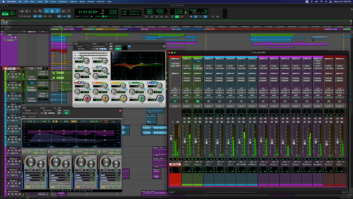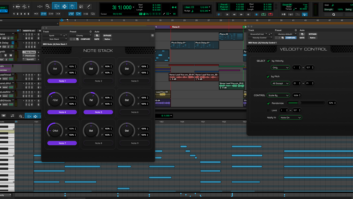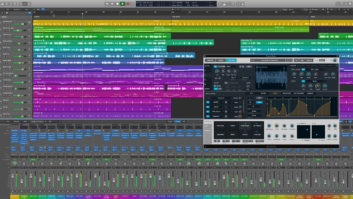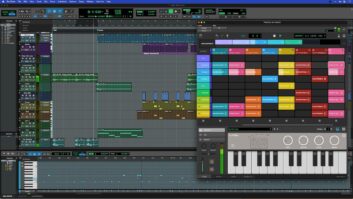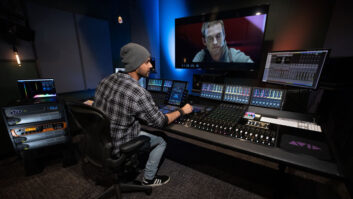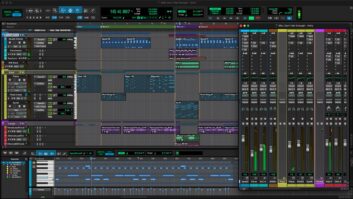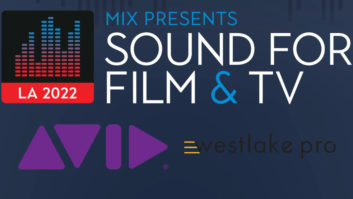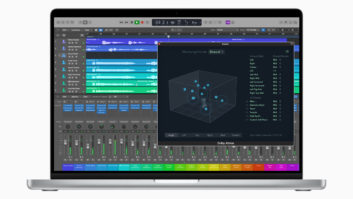Pro Tools HD 7 (Mac OS X and Windows XP) is an elegant and refined workstation upgrade that combines greatly enhanced processing capabilities with tighter integration of audio recording/editing/mixing and MIDI sequencing. Included in the upgrade are a lot of welcome features that users have been asking for, including the ability to copy and move sends and drag any type of audio file directly into the timeline. In addition, plug-in performance is vastly improved, and Digidesign has made MIDI a larger priority. All this adds up to an upgrade that is a no-brainer right out of the box.
GETTING TO KNOW YOU
Version 7 is a paid upgrade you can buy online ($245, CD; $175, software/online) and requires an iLok dongle. For this review, I installed V. 7.1cs4 into a Mac G5 quad-core with 4.5 GB of RAM running OS 10.4.2, HD 3 PCIe cards and a single 192 I/O unit. On launching a session, the first thing you’ll notice is the reorganized set of drop-down menus. I found this reshuffling logical, even though I would occasionally have to hunt around for little-used commands.
New menus called Track, Region and Event have replaced the Movie and MIDI menus. Track has everything to do with tracks: creating, deleting, duplicating, grouping, split to mono, etc. When a track region is selected in the Edit window, Region controls its properties; included is a new feature called Region Grouping (more on that later). Event is where most MIDI commands, tempo manipulations and Beat Detective now live.
The Event pull-down menu is where most MIDI commands, tempo manipulations and Beat Detective now live.
The shorter File menu has, in addition to its usual Open and Save dialogs, import for movies, session data, region groups, audio, audio from QuickTime movie, MIDI to track and MIDI to region. File is also where you can export session data as text and where OMF export occurs.
The Setup menu is the same as Session Setup except that it now contains the controls for offsetting movies to timecode, the MIDI interface setup and click settings. Also new is the resizable I/O window, which is a big help if you have a large system with numerous I/O boxes. In general, most of the dialogs and contextual menus are redesigned with many subtle changes that make life a lot easier. Apart from the very small icons added to sections of the Edit window, the interface looks largely the same as it previously did.
HTDM OUT, RTAS PERFORMANCE IN
Digidesign claims a 150-percent RTAS performance improvement in Pro Tools HD 7 TDM and LE systems as long as you are running a dual-processor or dual-core computer. Increasing the number and types of plug-ins possible has rendered (for other reasons) the HTDM format obsolete. One of the first dialogs I got when instantiating a plug-in was something like: “This plug-in could not be made active because this version of Pro Tools does not support HTDM plug-ins. If you cannot convert the plug-in to RTAS, please contact the manufacturer for an updated version.” I had no problems because plug-in developers offer RTAS versions of their wares anyway. If you start up an old session that used HTDM plugs, an RTAS version will usually replace them. Otherwise, you’ll have to check with the plug-in manufacturer for an updated Pro Tools HD 7 version.
For my totally unscientific test of improved RTAS performance, I played 49 tracks of mono audio, set RTAS processors to four (the quad-core Mac allotted all four processors to handle RTAS processing), CPU usage limit at 95 percent (max), 96 voices using two DSP processors, sample rate at 44.1 kHz and DAE playback buffer at Level 2 (default). I was able to instantiate 96 IK Multimedia T-RackS RTAS EQ plug-ins and 96 D-Verbs with more to go if I wanted; apart from my 48-bit TDM mixer at 78 percent, I still had all my TDM DSP resources. The PCI meter was at halfway, and the CPU was up about one third with 58 of 512 time slots used.
BUT WAIT, THERE’S MORE
Version 7 supports up to 160 channels of I/O at up to 96 kHz; up to 10 sends per track (in two blocks of five), with drag-and-drop copy of send assignment and settings; and up to 999 marker/memory locations. When you mouse over items in main windows, Tool Tips balloons (which you can turn on or off in Setup/Preferences/Display) will show function names and details, such as which plug-in you have inserted. (Love this.) Mixer fader range is now fixed at +12 dB, and bounce-to-disk is a keyboard shortcut: Command+Option+B. The built-in DigiBase file-management system supports MIDI data and Redbook audio CD import for PC users. Speaking of PCs, Pro Tools HD 7 uses the same non-backward-compatible .ptf session file format on both PCs and Mac platforms.
Instrument track combines an aux and MIDI track into one channel; MIDI instruments insert into an
Instrument track like effect plug-ins. The Instrument track view is offered in the Edit and Mix windows
Pro Tools HD 7 now imports REX and ACID files; I pulled .rx2 loop files directly from the Finder window onto a tempo-based session audio track without any conversion. The loop audio shows up as a Region Group with tempo information imbedded.
REGION MANAGEMENT
Both audio and MIDI regions now show up together in a single region list in the right-side drawer of the Edit window. The default sorts by type, with audio at the top. Tracks of all types — audio, instrument (more later), MIDI, aux or master fader — are listed in the left-side drawer under Tracks.
Region groups are collections of audio and/or MIDI regions; they can be thought of as a single track. Region grouping is a good tool when you are working on edit-intensive sessions, such as songs with chopped-up and quantized multitracked drum kits. Normally, tracks with many regions should be locked to keep the edits intact or (if they are audio) consolidated into a contiguous file. With region grouping, you can ungroup any time if you have to tweak an edit and then regroup to “fly” the entire region group anywhere.
You can group audio with MIDI tracks, as well as group together multiple region groups — great for working with large track-count sessions. It’s also possible to loop a region group and know that all the internal edits remain intact. A selectable crossfading function smoothes out any bumps between the head and tail of the looped region group. With REX loops, just change the tempo (using time compression/expansion) once at the start of the first file; the rest will change automatically. Unlike a mix group, all tracks within a region group retain their track mixer automation independence — cool beans!
MIDI, MIDI, MIDI
Although Pro Tools HD 7 still does not have a graphical MIDI events editor page where all MIDI data and tracks are viewed at once, MIDI editing, sequencing and operation garnered special attention in this upgrade.
An instrument track channel strip combines an aux track with a MIDI track. The strip offers Record Enable, Mute and Solo buttons; volume and pan faders; sends; inserts; automation; delay comp; VU meters; and I/O like an audio channel, but adds MIDI I/O selectors, a velocity meter that indicates MIDI data input to that channel only, and MIDI mute, pan and volume controls. MIDI volume and track mixer volume are separate adjustments. MIDI instruments insert into an instrument track like effect plug-ins.
Like any other track feature under the View menu, an instrument track view is offered in both the Edit and Mix windows. In the Edit window, the instrument’s piano keyboard (like a MIDI track) shows eight octaves (in Extreme), and you can click to show only a single note, saving vertical space; for example, if only a kick drum plays one MIDI note on that track. You can also audition (without changing or adding) any note by clicking and holding the Command key.
Pro Tools HD 7 introduces real-time MIDI operation governed by the Real-Time Properties window under the Event pull-down. Real-Time sets parameters such as note duration, delay, velocity, transpose and quantize with a choice of groove templates from the MPC, Logic, Cubase and Feel Injector. The updated Input Quantize window also has these groove templates.
Real-Time Properties can be applied to an entire track or to individual regions as needed on the fly. I found that I could audition the changes to a region but leave it as is. Later, if you want to commit to changes to just that region and/or others, you can “Write to Region” and see the change on the instrument track in the Edit window.
Instrument tracks or MIDI tracks with real-time settings other than the defaults display a “T” in the upper-right corner; changes to specific regions within that track display an “R.” Looped regions can use a new feature called Mirrored MIDI Editing, where an edit to one region applies to all other MIDI regions of the same name.
In earlier Pro Tools software, MIDI data defaulted to tick-based timing — bars/beats, no matter the tempo change. Audio has always been sample-based, but Pro Tools HD 7 allows for audio and MIDI data to be either sample-based or tick-based. Tempo changes only affect the start or sync point of tick-based audio. Tick-based MIDI note data changes duration with tempo changes. Sample-based MIDI events stay fixed to the timeline despite tempo change. This is an incredible capability for the user who is composing, editing and manipulating film-score music to picture.
Offline MIDI editing benefits from many time-saving features. Split Notes offers the option of assigning the new notes to the clipboard, a new track or a new track per new note. This is great for untangling composite MIDI data or to reassign different instruments to certain note ranges. Select Notes (now combined with Split) has more criteria options such as velocity and duration. The new Remove Duplicate Notes removes dupes in a selected region, and under the Change Duration menu, Remove Overlaps leaves a designated gap between same notes.
ALL-ENCOMPASSING SYSTEM
Pro Tools HD 7 is more than this year’s model of Digidesign’s flagship product, more than last year’s model polished up with a few bells and whistles thrown in. Coupled with a dual-processor computer, this is a big jump in performance, speed and efficiency with many “power-user” features built in that are well-worth learning and adding to your style of working.
Digidesign, 650/731-6300, www.digidesign.com.
Barry Rudolph is an L.A.-based recording engineer. Visit his Website at
www.barryrudolph.com.
Pro Tools HD 7 startup screen
The new Tool Tips feature adds “roll-over” descriptions of objects in the Pro Tools software interface.
A window shows systems usage.
Pro Tools 7 introduces real-time MIDI operation governed by the Real-Time Properties window under the Event pull-down.
Select Notes (now combined with Split) has more criteria options such as velocity and duration.
New Region Groups allow grouping of any combination of audio and MIDI regions, across any number of tracks
Support for quantizing audio regions according to a grid or groove template
under the Change Duration menu, Remove Overlaps leaves a designated gap between same notes.
An Instrument Track Channel strip combines an Aux track with a MIDI track. The strip offers Record Enable, Mute and Solo buttons, volume and pan faders, sends, inserts, automation, delay comp, VU meters and I/O like an audio channel, but adds MIDI input/output selectors, a velocity meter that indicates MIDI data input to that channel only, and MIDI mute, pan and volume controls.
